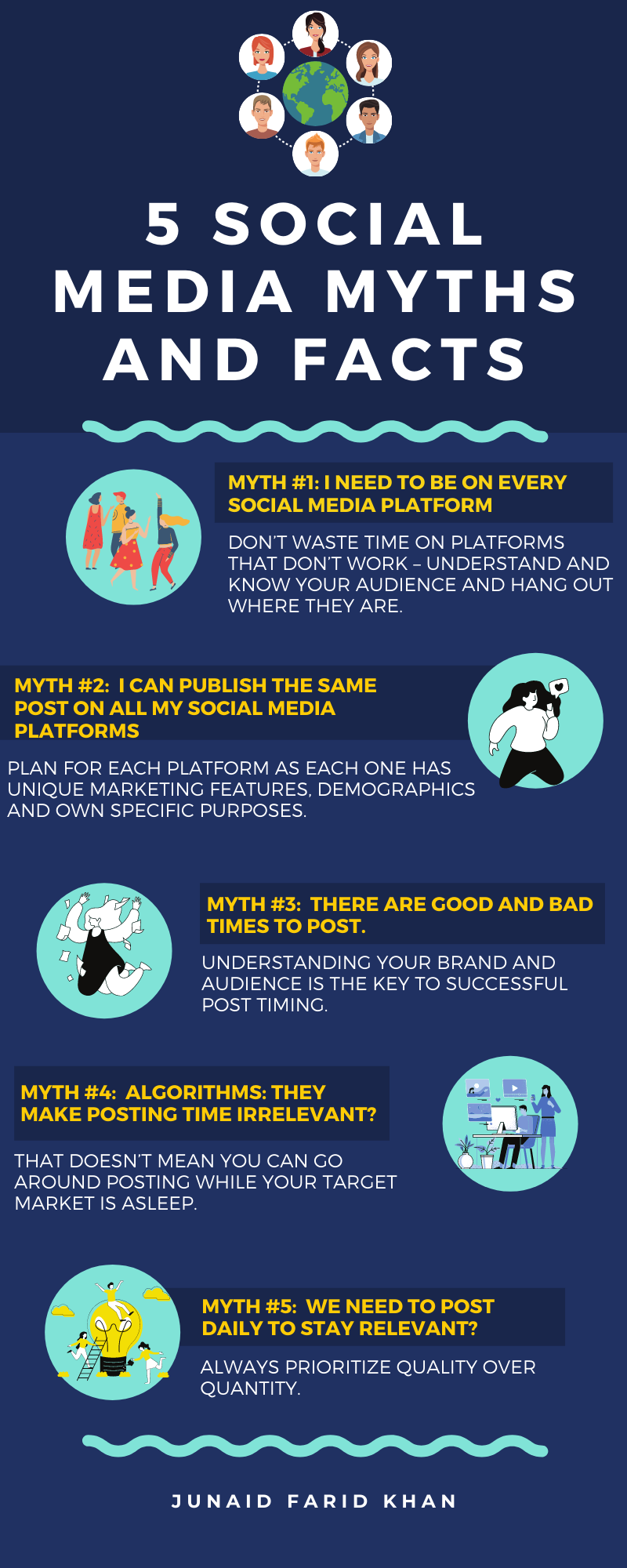After writing "50 social media tips for Insurance Practitioners", I was asked by a number of people about the best practices of social media marketing. During my interaction with them, I found that while the practice of social media marketing has evolved and matured as a business process, some common myths and misconceptions around social media as a marketing tool still exist.
A lot of businesses view social media as a “magic bullet”, and they expect overnight results. However, a lot of them fail to understand that it has to be used strategically and with realistic expectations, needs long haul planning – showing up every day, providing great content and building and engaging with their community.
Download: 50 social media tips for insurance practitioners
To provide some perspective on this, here are some of the more common social media marketing myths, and their corresponding truths, to help you maintain more realistic expectations.

Myth #1: I Need to Be On Every Social Media Platform
Many businesses believe they need to have a presence on all of the social media platforms.
Fact: It’s a false assumption. Imagine you start a restaurant at a place where there are no people around. Will your business succeed?
Similarly, you need to be on social media where most of your clients are. Don’t waste time on platforms that don’t work – understand and know your audience and hang out where they are.
Once you have managed to figure out where your crowd is, you should only use as many platforms as you can manage effectively.
Doing social well requires spending time creating quality content and also engaging in conversations with your community. If you are not responding to comments, questions and engagement, this will do more damage in the long run.
Myth #2: I Can Publish the Same Post on All My Social Media Platforms
To save time, many businesses will create a single social media post that they will push out to all of their social media platforms.
Fact: Many people think that all social networks are equal – but they’re not. They all have their unique marketing features, demographics and own specific purposes. Understanding their purposes and what to use each channel for will give you a better understanding of how to use them for your businesses.
One of the largest factors to consider when sharing your messaging on any social media platform is how conversations shift with each channel. For example, conversations you may have on LinkedIn can be quite different from those you have on Instagram, Facebook or Twitter.
LinkedIn is a professional platform. Most B2B businesses can find their ideal clients on this platform and should tailor their posts and content to appeal to this group. Instagram on the other hand is heavily used by Millennials and businesses by creating graphics and images that emotionally connect with their audience.
Myth #3: There are good and bad times to post.
Many businesses, without doing proper research, believe that the posts should be limited to a specific time.
Fact: While there’s an abundance of information on the internet about the best times to tweet or post on social networks, there’s no “one size fits all” solution that will mean success for your content.
Successful post timing depends on the platform, brand, industry, and target audience. Remember, every social media platform has a core user base that behaves in a unique way. For a truly efficient social strategy, you need to dig deeper.
Focusing simply on generic “good” or “bad” posting times can isolate you from your larger audience.
When determining the posting times, focus on the details: What do you sell? What is your industry? Who makes up the audience you are trying to reach, and when will they be most active on social platforms? Understanding your brand and audience is the key to successful post timing.
Myth #4: Algorithms: They Make Posting Time Irrelevant?
Many businesses believe that with algorithms in place on almost all social media platforms, the posting times don’t matter anymore.
Fact: Social media algorithms are a way of sorting posts in a users’ feed based on relevancy instead of publish time.
Social networks prioritise which content a user sees in their feed first by the likelihood that they’ll actually want to see it. But that doesn’t mean you can go around posting while your target market is asleep.
Well-built algorithms combine behavioural data from millions of samples to determine which audiences have the highest value and what kind of content they will receive. Ideally, if your content is engaging, then the algorithm should pick it up.
Myth #5: We need to post daily to stay relevant?
We need to post every day so that our clients see us active on social media.
Fact: Few skills will make or break your social media success more than posting frequency.
If you post too infrequently, your audience will forget that you exist and you will quickly fade into the deep dark recesses of their minds. However, if you are posting too often, you will look like spamming their feeds. You need to strike a balance and also come up with quality content for each post.
Consistently posting high-quality content is the right way to go when considering how often to post on social media. Always prioritise quality over quantity.
Don’t get caught in a trap of multiple daily posts, only to lose your brand power with mediocre content. The more relevant and timely your content is, the more value and engagement you can generate.
More marketing content for you:
Marketing during lockdown - 3 ways to reach your customers
How to grow 1,000 organic twitter followers in four months
5 ways an adviser can win the trust of a client - a marketer's perspective!
How to write a LinkedIn Post